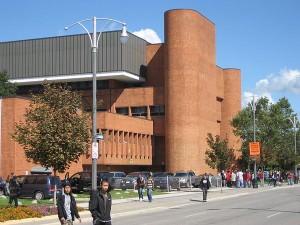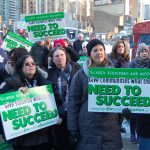Systemic Racism and Class Inequality a Reality in Hamilton School Closures
Last year, I attended Louder Than a Bomb, a spoken-word event by high school students in Hamilton. In one performance, students at Sir John A. Macdonald (SJAM) spoke out against the perception that their school is dangerous because it is located downtown in a low-income, immigrant neighbourhood.
The students showed pride in their diverse and vibrant school where the supports and dedication provided by teachers and staff have inspired many students to succeed. They also expressed a sense of injustice that their school was closing down.
SJAM is Hamilton’s only downtown high school. It has a large number of Black, Aboriginal, Asian and Muslim students. It offers strong programs to support Newcomers through their ESL program and Aboriginal Students through the Aboriginal Stay-In-School Initiative and through their Native Studies program which offers all students a greater understanding of Native culture. It is not yet clear whether these programs will be offered elsewhere.
SJAM’s central location makes it accessible by local transit and it is surrounded by local amenities including the local mosque, Central Public Library, James Street North Arts District, and agencies serving youth in the area.
The school is also close to many high-rises in the neighbourhood occupied by newcomers and low-income families. Having a school that is further away creates barriers to education for students who may already have challenges staying in school.
School closures often happen in low-income neighbourhoods where they are needed the most. In 2015, a report by the Elementary Teachers Federation showed that more than two-thirds of schools slated for closure by the Toronto District School Board were in poorer neighbourhoods. This is consistent with other school closures across North America.
One factor for this is that parents in these communities have less resources and influence than parents in wealthier neighbourhoods. As a result, their voices are often ignored by the powers that be who feel their positions will not be threatened for closing poorer schools.
SJAM was not originally slated as an option for closure as it was not one of schools identified as having low enrollment. But during the Hamilton-Wentworth District School Board’s’ (HWDSB) Accommodation Review (AR) process, parents on the AR committee opted for a new school, which meant closing SJAM along with Delta and Parkview, two other schools that also serve low-income students.
An AR is done when the school board wants to close or consolidate a school due to low enrollment. The review process is set up in such a way that it pits one community against another.
Schools that aren’t initially considered for closure often end up being closed, as parents in wealthier neighbourhoods try to stake out what is best for their children, and immigrants and low-income communities end up with the short end of the stick.
Sometimes immigrant and low-income families are not even aware that a decision is being made without their input. The minutes to the AR process reveal that the voices of SJAM parents and students were missing from the consultations.
Delta and Parkview parents tried to save their schools, but the HWDSB’s short-sightedness pushed forward with the closures despite the negative impacts it will have on all neighbourhoods in the lower city.
The fact that the province removed the requirement to consider community impact from the AR process and the school board’s willingness to go along with the process shows a lack of concern on the quality of education for low-income and immigrant communities.
Hess School Also at Risk
Now the local elementary school, Hess school, located in the same neighbourhood as SJAM, is also facing the threat of closure. Students at Hess are also largely made of refugees and new immigrants and come from over 30 countries.
The fact that the school board has not made any significant investments in this school since 1974 and is now proposing to close it, highlights the stark reality of how inequality is played out in the education system. Meanwhile, other higher-income neighbourhoods have had new schools built.
Of the nine schools in the present AR process, Hess is the only one slated for closure. During the AR committee meetings, five white parents from wealthier southern schools did not recommend to keep all schools open. They see the closure of schools outside of their neighbourhoods as beneficial for them as it could mean funding for renovations or additions for their schools.
Systemic racism and class inequality is a reality in school closures. For instance, Westdale, which has about the same enrollment numbers as SJAM, is located in a wealthy neighbourhood that would never face the threat of closure. The school board would never have closed Westdale and told students there to go to SJAM. Instead, it is SJAM students who must be inconvenienced by going a further distance to get to school.
The lack of investment in immigrant and low-income schools is one of the barriers this demographic faces in access to quality education. The school board, whose staff and trustees are mostly white, do not have a real understanding of low income and immigrant communities.
These communities are already at a disadvantage when it come to accessing and influencing the political process. As a result, despite SJAM and Hess not having low enrollment, they have become casualties in the HWDSB’s aggressive quest for funding – funding that would primarily benefit wealthier schools.
We are now living in a world where there is growing xenophobia, Islamophobia and racism. Schools like Hess and SJAM can be a place to bring communities together and provide education against myths and stereotypes of immigrant, aboriginal, and low-income communities.
Closing these schools and leaving a neighbourhood with a large immigrant population without any schools is an injustice that should be challenged.



